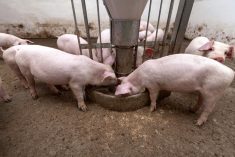Climate consciousness has been replaced by a sense of urgency, much of it focused on Canadian agriculture.
Before we begin the climate conversation, let us go to other areas of the world.
Recently I spoke at length with friends in Europe where the momentum on climate action in Germany had resulted in embracing wind power. The public then denounced wind turbines as ‘ugly’ and so strong was the backlash that by the end of 2021 much of Germany’s power was again produced by coal — in a country that now houses about 83 million people who own 43 million cars in an area half the size of Alberta.
Read Also

Guarding against misinformation: Do you believe in house hippos?
Misinformation and disinformation run rampant in today’s digital age. Farmers must be wary of the digital dangers and know how to keep themselves safe.
While the coal burns because the turbines are ugly and nuclear power is being shut down, the autobahns which now do not have speed limits, attract additional polluting drivers from all over the world who simply want to drive fast.
And while that all sounds like infectious fun, farmers in Germany (where land sells for six figures an acre in some areas) are very much in the web of the newly minted Climate Action Law. This law was enhanced by a court ruling on the basis that, in its original form, it was insufficient to protect future generations from climate outcomes. The climate targets in the ruling were then reset to a 65 per cent reduction in greenhouse gases (GHG) by 2030 and net zero emissions by year 2045. (In contrast, Canada’s targets and timelines are a 45 per cent reduction in GHG by 2030 and net zero by 2050.)
- More with Brenda Schoepp: The food sector is much bigger than you might imagine
German farmers feel the timelines are too short to accomplish the reductions in GHG without alternatives in fuel or fertilizer, technology, infrastructure and systems.
For example, if hydrogen is an alternative and becomes mandatory (such as being discussed in Chile) there has to be an infrastructure to support it. The transition to new technology, structures, infrastructure and systems to feed and house animals, grow crops, dispose of food waste, change agronomic practice and mitigate emissions is costly for agriculture. In Canada, that cost has been estimated by RBC to be a $2-trillion price tag and requires an extra 200,000 persons as green technicians in agriculture alone.
Who will fund this?
The German farmers are vocal that it is energy and climate funds that will pay for transformation in technology and practice. But in the background, farm subsidies are being reduced, leaving the beginner and lower-income farmer at risk. Special interest groups are calling for less livestock production in a country that not only loves sausage but has a high dependency on meat exports.
Non-compliance becomes the responsibility of government, according to the ruling. This translates into potential government investment outside of Germany in order to secure carbon credits as the public strongly opposes domestic carbon capture and storage.
To date, the value of carbon credits that have traded in Canada has been determined by those outside of agriculture and outside of our borders. Value has not been determined by domestic farmers. This is deeply troubling because the Canadian carbon market is not regulated, secure or liable nor do we have an appropriate formula to determine appreciating value on farm.
Climate change action should not focus on sectorial or industry marks for the sake of quick wins but be inclusive of an economic society.
Food producers will successfully tackle the challenges if they are part of the dialogue and the determination of value. The Dairy Farmers of Canada recently announced it will be offering “a basket of initiatives” that producers can select based on their operations.
Last year Canada set aside $8 billion for large manufacturers and just $500 million for ag-related climate initiatives. If that $8-billion support was reflective of the manufacturers’ contribution to national GDP, then agriculture, nearly equally as great a contributor, would be the recipient of $7.2 billion for climate initiatives.
I am concerned that agriculture, as a powerful contributor to the economy, will carry the bulk of the responsibility on a shoestring budget.
Equally concerning is the Net Zero Banking Alliance, of which 98 banks representing 43 per cent of global banking assets have signed on. The goal is to transition to net-zero clients by “aligning lending and investment portfolios with net-zero emissions by 2050 with an immediate target of 2030.”
What we do not know is how this impacts a farmer’s access to capital in the future nor do we have an indication of just who will determine if the farm or ranch is compliant.
I believe in setting targets and in reaching for goals. More important is a systems approach to such measurables, which includes support for farmers through the transition and a baseline of appreciating worth in plant and soil carbon.
This we must own as well as the accompanying ‘value’ for the food produced in a regenerative framework. In all climate action, our consumers must be able to access and afford nutritious food.
Regardless of where you farm and what you eat, farmers are change agents and farming is the solution. This has unprecedented future value for Canadian agriculture.
















